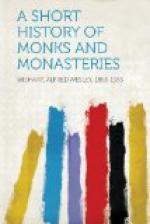The difficulty of ascertaining when and by whom Christianity was originally introduced into southern Britain must be apparent to every student. But some things may be regarded as historically certain. The whole country had been desolated by war when Augustine arrived. For a hundred and fifty years the brutality and ignorance of the barbarians had reigned supreme. All traces of Roman civilization had nearly disappeared with the conquest of the heathen Anglo-Saxons. Whatever may be thought about the subsequent effects of the triumph of Roman Christianity, it is due to Rome to recognize the fact that with the coming of the Roman missionaries religion and knowledge began a new life.
The Anglo-Saxons had destroyed the Christian churches and monasteries, whose origin, as we have seen, is unknown. They drove away or massacred the priests and monks. Christianity was practically extirpated in those districts subject to the Germanic yoke. But when Augustine landed British monks were still to be found in various obscure parts of the country, principally in Ireland and Wales. Judging from what is known of these monks, it is safe to say that their habits and teachings were based on the traditions of an earlier Christianity, and that originally British Christianity was independent of Rome.
The monks in Britain at the time when Augustine landed differed from the Roman monks in their tonsures, their liturgy, and the observance of Easter, although no material difference in doctrine can be established. The clergy did not always observe the law of celibacy nor perhaps the Roman rules of baptism. It is also admitted, even by Catholic historians, that the British monks refused to acknowledge Augustine their archbishop; that this question divided the royal family; and that the old British church was not completely subdued until Henry II. conquered Ireland and Wales. These statements are practically supported by Ethelred L. Taunton, an authoritative writer, whose sympathy with Roman monasticism is very strong. He thinks that a few of the British monks submitted to Augustine, but of the rest he says: “They would not heed the call of Augustine, and on frivolous pretexts refused to acknowledge him.” A large body of British monks retired to the monastery of Bangor, and when King Ethelfrid invaded the district of Wales, he slew twelve hundred of them in the open field as they were upon their knees praying for the success of the Britons. It was then that the power of the last remnants of Celtic or British Christianity was practically broken, and the Roman type henceforth gradually acquired the mastery.




